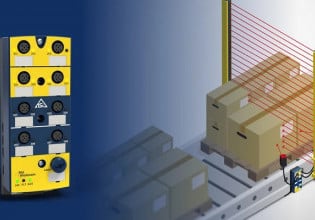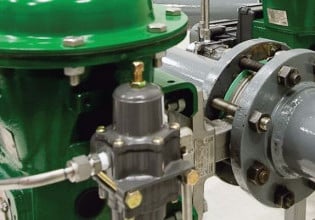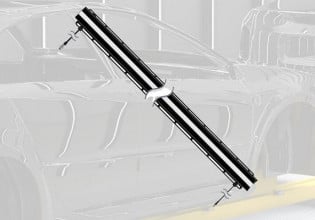Development Platforms for Next-gen Industrial Drive Designs
Learn about the benefits of industrial drive development platforms and how features like multi-axis motor control, data logging, remote monitoring, fault detection, and cybersecurity can support your next-gen design.
Industrial drives are critical to many applications, such as motor control for industrial, collaborative, and mobile robotics, digital manufacturing, and multi-axis machinery. Next-generation industrial drives, designed with technology that optimizes operation based on data-driven decisions cannot depend on old technology or outdated development platforms.
In this article, learn more about the benefits of industrial drive development platforms and how features like multi-axis motor control, data logging, remote monitoring, fault detection, and cybersecurity can support your next-gen design.

Figure 1. Robotic arms used in welding, assembly, and material handling for automated systems in factories require multiple motors to achieve multi-axis movement. Image used courtesy of Pixabay
What Is a Modern Industrial Drive?
Modern industrial drives can be described in part by the term IIoT, or Industrial Internet of Things, with features such as intelligent optimization, wireless communication, data sharing, predictive maintenance, and remote diagnostics.
Next-generation industrial drives need real-time deterministic Ethernet communication, which TSN (Time-Sensitive Networking) communications aid in achieving. Modern industrial drives also include complex MTM (Machine To Machine) command structures. And not all communication occurs between digital systems: industrial drives also need a level of human involvement through a straightforward HMI.
These drives are certified to meet the ISA/IEC 62443-4 SL3 global standard for automation and control. The ISA/IEC 62443-4 standards deal with product security development life-cycle and technical security requirements for IACS components. Its objective is to secure equipment and operations against cyberattacks.
Benefits of Design Platforms for Industrial Drive Development
Industrial drive development platforms enable engineers to develop and evaluate individual use cases for industrial drives on a single, all-in-one platform. Such capabilities reduce the complexity of multiple phases of development, from design through testing. These platforms also make it possible to complete design, implement, and comprehensive testing more efficiently and decrease the time to market for a drive.
Industrial drive development platforms provide a single source for design, evaluation, and testing, which makes comprehensive security testing much more manageable.
And perhaps the most significant benefit of using an industrial drive platform lies in allowing engineers to focus on cutting-edge advances.

Figure 2. Some of the key capabilities for industrial drive platforms. Image provided courtesy of NXP
Features of Platforms that Support Next-gen Industrial Drive Development
There are several critical features for modern industrial drive development platforms, including those summarized in Figure 2. Development should take a modular approach to add flexibility and scalability, especially when unique design requirements are involved.
For example, a three-board design might include the following:
-
One (or more as needed) power stage board to handle the output power needed to control motors
-
A daughter card used to integrate an MCU device
-
A digital board serving as an expansion peripheral board for the aforementioned daughter card
Applications rapidly move toward Industry 4.0 and away from standalone modes (where a device is not connected to a network). This move toward network connection and communication requires deterministic communication, which refers to the ability of a network to ensure that messages or certain events will occur within a specified, highly predictable time period. An essential aspect of deterministic communication is Ethernet TSN, especially when actuators (in this context, motors) are involved.
In an industrial setting, many multi-axis machines, including those for robotics and digital manufacturing, require the operation of multiple motors to fulfill their purpose.
For next-generation designs, multi-axis motor control supporting up to four motors from one MCU is extremely important and offers benefits such as fewer cables and networking components, as well a reduction in the overall number of drives required (e.g., a quad-axis motor can potentially take the place of four individual motor actuators).
Data logging makes accessing, monitoring, analyzing, and day-to-day auditing operations for Industrial 4.0 factories and facilities easy. Data logs record faults, errors, data, user access, and alarms, and the more comprehensive the log, the easier it is for field engineers to optimize industrial systems. In addition, an excellent industrial drive development platform provides support to aid in the design and integration of data log subsystems.
Connectivity for IIoT continues to expand, including the data needed for remote monitoring. Practical, reliable remote monitoring means that industrial drive development platforms should support the establishment of both a secure channel between devices and a monitoring system.
In the same vein as data logging and remote monitoring, we have fault detection, which means devices detect and react appropriately to system faults such as current spikes, high temperatures, and signals transmitted from other devices. A drive development platform must support fault detection and instant interrupt services.
Engineers must address several cybersecurity aspects, starting with secure user interaction. One highly effective approach to ensuring secure user interaction is security-by-design which enforces authentication and verification for human users and machine-to-machine interactions. Systems must also react appropriately to cyber-physical attacks, which go beyond returning to a previously trusted state to a cyber-resilient approach that removes non-trusted code.

Figure 3. The NXP i.MX RT, an industrial drive development platform, provides engineers with the support needed to create cutting-edge multi-axis designs. Image provided courtesy of NXP
Introducing the NXP i.MX RT Industrial Drive Development Platform
NXP specifically engineered the i.MX RT industrial drive development platform, shown in Figure 3. It’s a single-chip, modular solution for multi-axis motor control for next-generation Industry 4.0 and IIoT technologies.
The i.MX RT development program fully supports a multi-board approach with three primary boards: the daughter card, integrating a single i.MX RT1170 crossover MCU; a digital board that serves as the extension peripheral board for the daughter card; and a power stage board handling 200W of output power. It also includes the option of adding between one and four power stage boards to the system.
The daughter card MCU is a 6468 CoreMark with Cortex-M7 up to 800 MHz + Arm Cortex-M4 up to 400 MHz, including 2 MB SRAM with 512 KB of TCM for Cortex-M7 and 256 KB of TCM for Cortex-M4.
For deterministic communication, the i.MX RT MCU includes 1 Gb ENET TSN and can seamlessly integrate with operational technology networks. The platform provides comprehensive data-logging capabilities and supports engineers that need to integrate their data log subsystem within IIoT devices.
For remote monitoring, the i.MX RT Industrial Drive Development Platform guides developers in establishing a secure channel between the end device and monitoring systems. In addition, this development platform includes full fault detection functionality and leverages instant interrupt services within its software architecture.
To ensure cybersecurity, it utilizes the security-by-design approach via NXP EdgeLock to enact security policies necessary in facilities managing critical infrastructure, including secure boot and crypto engines. This platform includes secure RTC, ciphers and RNG, and fuse and HAB. Also, note that EdgeLock SE05X is Common Criteria EAL 6+ certified up to OS level and fully supports comprehensive encrypted communications and secured lifecycle management.
While this platform does not, at this time, grant automatic ISA/IEC 62443-4-1,-4/2 certification, it does serve as a reference for compliance, easing the burden on engineers. Note that NXP does plan to provide IEC 62443-4-1/2 certification in the near future.
Conclusion
The NXP i.MX RT drive development platform is comprehensive, both in hardware and software and fully able to provide smart and secure development of IIoT applications for industrial drive applications. It helps engineers develop tomorrow's industrial drives with a modern approach to evaluation and testing. Contact NXP to discover how their technology can move your products into the future.






